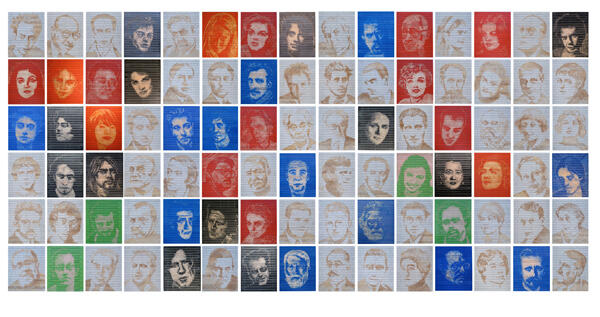Pedro Tyler
Sicardi Gallery, Houston
This fall Sicardi Gallery is featuring “Not Space Nor Time”, the first United States solo show of Uruguayan artist Pedro Tyler. The works included in this exhibit pose a reflection on art and death.

To be sure, the main piece in the exhibit is Darkening the light (2012). The title comes from a phrase by French philosopher Gilles Deleuze. Using a technique similar to woodcut, Tyler carved onto the surface of wooden rulers ninety bas-relief portraits of notable people in the arts who allegedly committed suicide. Among them are philosophers like Deleuze himself, writers like Ernest Hemingway, painters like Mark Rothko, photographers, musicians, poets, and movie directors. Each artistic practice is carved out on a different color of rulers: red, blue, green, black and white.
Tyler’s use of rulers as the support of all his works alludes to measuring. In fact, he quotes a notable phrase by Galileo Galilei that states, “Measure what can be measured and make measurable what cannot be measured.” It is a statement that shows the boldness and optimism at the onset of modern science, for it is indeed bold to think that things like beauty or imagination can be measured. However, Tyler appears more concerned about the materiality and use of rulers than about the logic of Galileo’s maxim.
The phrase “WE MUST PUT COLOR IN SHADOWS” is carved through on the yellow rulers of Tyler’s work titled Bloom (2012). In this work the rulers are joined and cut to resemble flowers. As beams of light shine onto the rulers and through the carved letters, the words are projected onto the wall so the viewer can reflect upon it. The phrase itself comes from a letter that Vincent Van Gogh wrote to his brother Theo in 1885. Referring to the Dutch painter Jozef Israëls, it states: “When Israëls says that one must not paint black, he certainly never means what they now make of it, he means that there must be color in the shadows.” Pedro Tyler’s proposition in “Not Space nor Time” seems to be to add to art and death not only color, but nuance as well.
-
 Darkening the Light, 2012
Darkening the Light, 2012
Bas Relief, wooden rulers
162" x 78" / 411.48 x 198.12 cm
Courtesy The artist and Sicardi Gallery, Houston.
© Laura Burlton Photography



